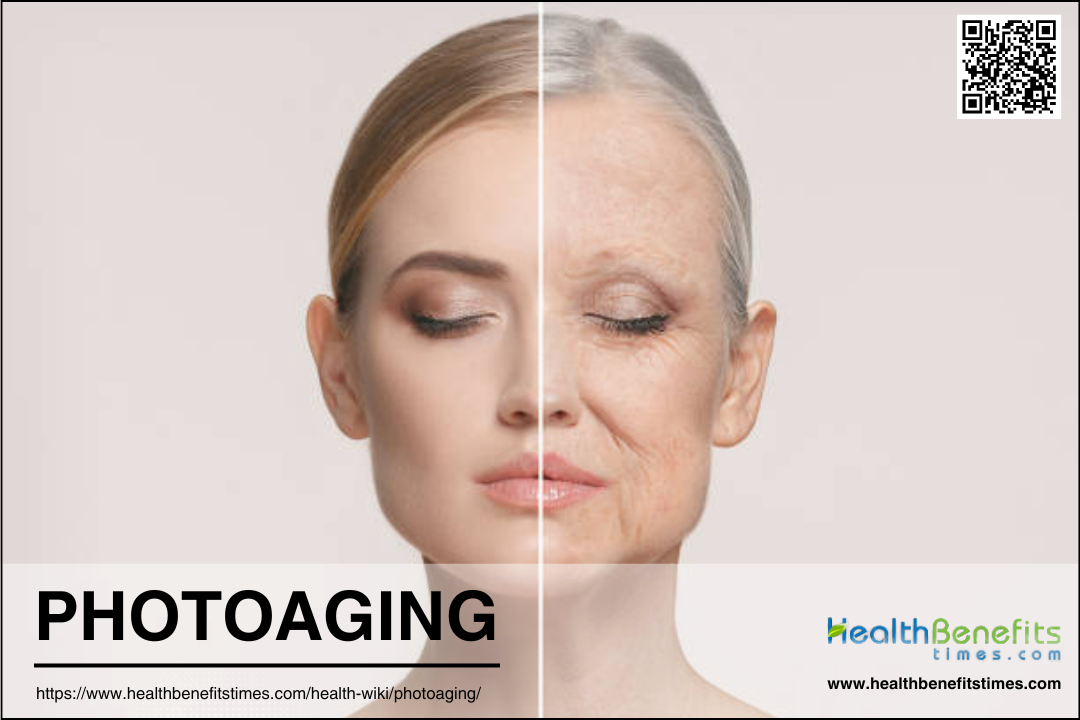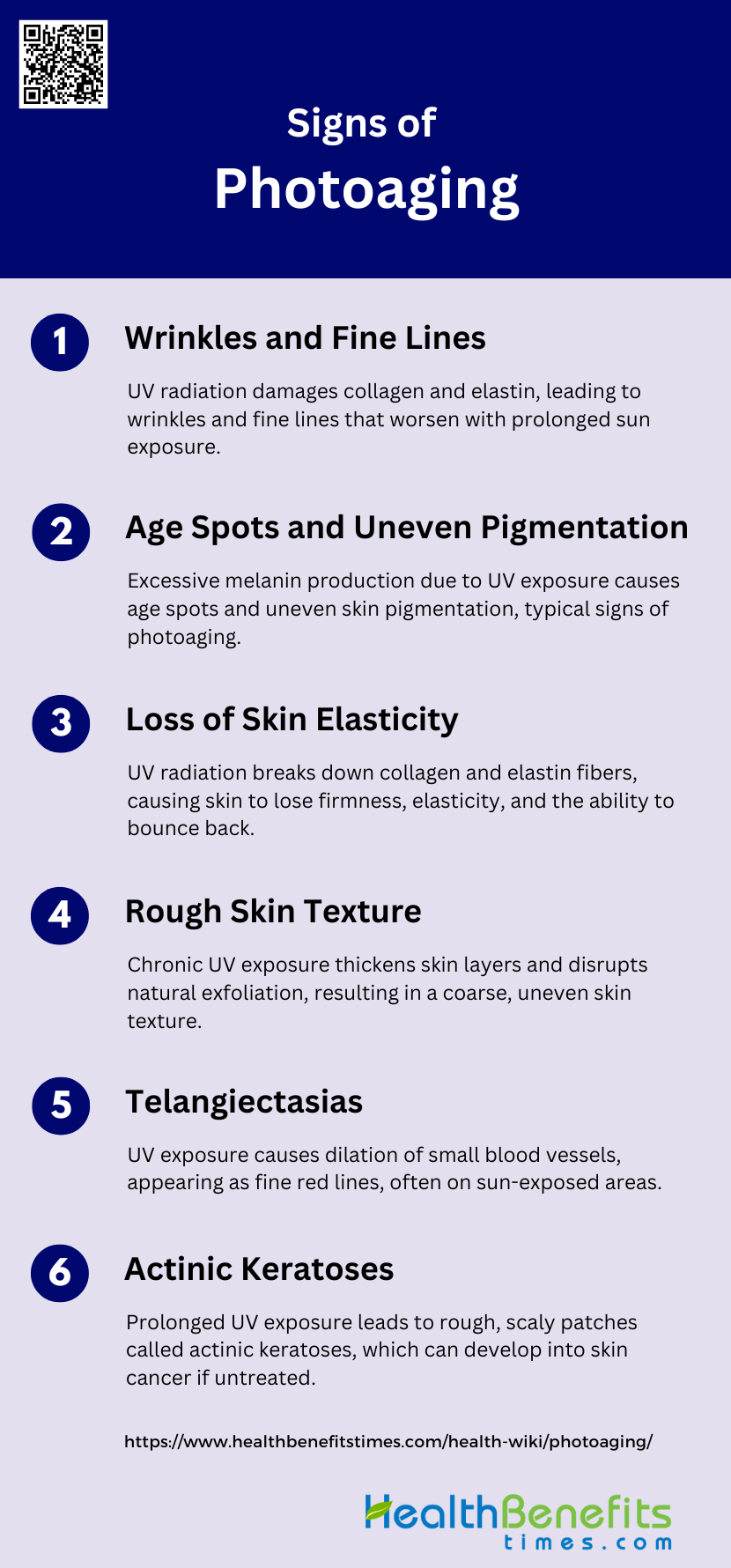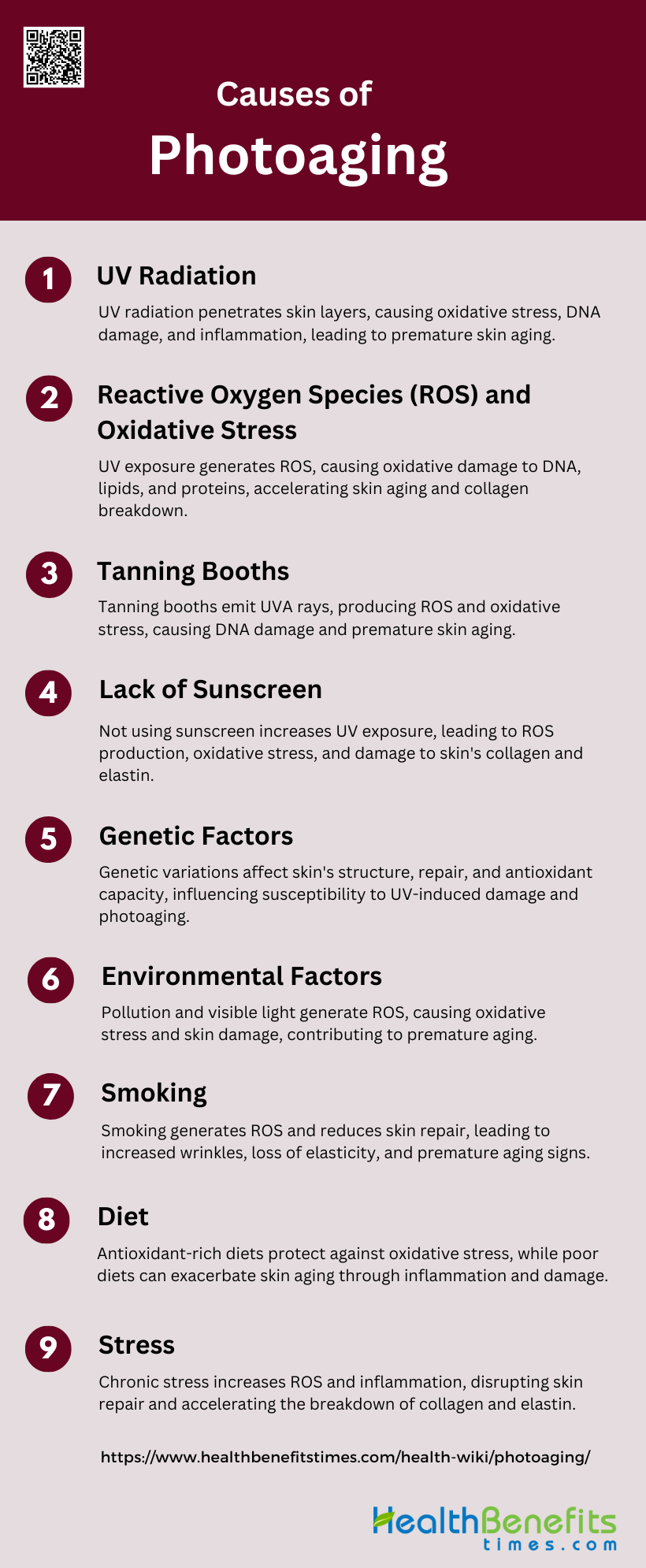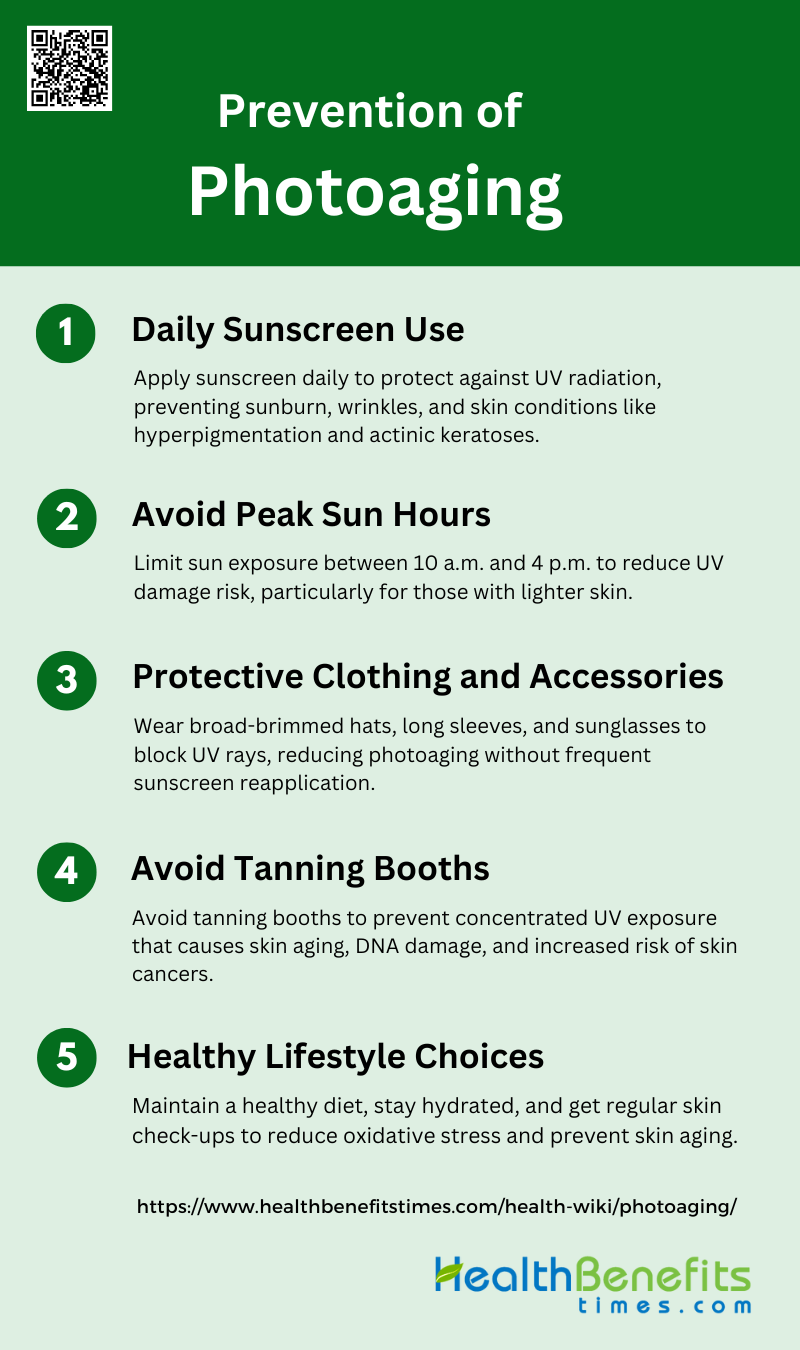Photoaging refers to the premature aging of the skin caused by prolonged and repeated exposure to ultraviolet (UV) radiation from the sun. Unlike intrinsic aging, which is a natural process, photoaging is characterized by distinct clinical, histological, and biochemical changes in the skin. These changes include coarse wrinkles, dyspigmentation, and telangiectasia, which are more pronounced than those seen in naturally aged skin. The underlying mechanisms involve the generation of reactive oxygen species (ROS) and oxidative stress, leading to structural and functional alterations in the skin’s components, such as collagen and elastin. Preventive measures like the use of sunscreens and antioxidants, as well as treatments like topical retinoids, have been shown to mitigate the effects of photoaging. Recent advances in skin biology have also led to the development of new therapeutic strategies aimed at repairing UV-induced damage and rejuvenating the skin.
Difference between photoaging and intrinsic (natural) aging
Intrinsic aging and photoaging are two distinct processes that contribute to the overall aging of the skin. Intrinsic aging, also known as natural aging, is a slow and inevitable process driven by genetic and chronological factors. It is characterized by a gradual loss of collagen, degeneration of the elastic fiber network, and reduced hydration, leading to fine wrinkles and a smooth, pale appearance of the skin. In contrast, photoaging is caused by external environmental factors, primarily ultraviolet (UV) radiation from the sun. This type of aging results in more pronounced skin changes, such as coarse wrinkles, dyspigmentation, and telangiectasia, due to the accumulation of abnormal elastin and increased collagen fragmentation. Photoaged skin also exhibits chronic inflammation and metabolic hyperactivity, with increased production of elastic fibers and glycosaminoglycans (GAGs), and enhanced inflammatory processes. While intrinsic aging affects the skin uniformly, photoaging is more localized to sun-exposed areas and can manifest decades earlier than intrinsic aging signs.
How the Sun Affects Photoaging
The sun significantly impacts photoaging, which is the premature aging of the skin due to chronic exposure to ultraviolet (UV) radiation. UV radiation, particularly UVA and UVB, induces various molecular changes in the skin, including the production of reactive oxygen species (ROS) and DNA damage, which lead to the breakdown of collagen and other structural proteins. This process results in clinical manifestations such as wrinkles, pigmentation, and loss of skin elasticity. The activation of matrix metalloproteinases (MMPs) and the impairment of the transforming growth factor-beta (TGF-beta)/Smad signaling pathway are critical mechanisms in the degradation of the extracellular matrix and the reduction of collagen synthesis. Additionally, environmental factors like air pollution and visible/infrared light can exacerbate photoaging. Effective photoprotection strategies, including the use of sunscreens and minimizing sun exposure, are essential to mitigate these adverse effects.
Signs of Photoaging
Photoaging refers to the premature aging of the skin caused by repeated exposure to ultraviolet (UV) radiation, primarily from the sun. This process accelerates the natural aging process, leading to various skin changes that can be both cosmetic and medical concerns. Below are some common signs of photoaging:
1. Wrinkles and Fine Lines
Wrinkles and fine lines are among the most noticeable signs of photoaging. Chronic exposure to ultraviolet (UV) radiation from sunlight leads to the breakdown of collagen and elastin fibers in the dermis, which are essential for maintaining skin’s structural integrity and elasticity. This degradation results in the formation of wrinkles and fine lines, which can be categorized into different types based on their severity and appearance. For instance, type I photoaging is characterized by “no wrinkles,” while type IV involves “only wrinkles”. The process is exacerbated by UVA rays, which penetrate deeply into the skin, causing significant damage to collagen fibers and leading to an abnormal increase in elastin production. This cumulative damage manifests as both fine lines and deeper wrinkles over time.
2. Age Spots and Uneven Pigmentation
Age spots, also known as lentigines, and uneven pigmentation are hallmark signs of photoaging. These pigmentation disorders arise due to the overproduction and uneven distribution of melanin, the pigment responsible for skin color, in response to UV radiation. The melanocytes, which produce melanin, become hyperactive and create dark spots on the skin, commonly referred to as age spots. Additionally, photoaged skin often exhibits dyschromia, which includes various forms of pigmentation irregularities such as mottled pigmentation and sallow complexion. These changes are more pronounced in photoaged skin compared to naturally aged skin, which tends to be more uniformly pigmented.
3. Loss of Skin Elasticity
Loss of skin elasticity is another significant sign of photoaging, resulting from the degradation of elastin and collagen fibers in the dermis. UV radiation, particularly UVA rays, penetrates deep into the skin and disrupts the normal structure and function of these fibers, leading to a loss of skin firmness and elasticity. This process is further compounded by oxidative stress, which accelerates the breakdown of these essential proteins. As a result, the skin becomes lax and less able to return to its original shape after stretching, contributing to the overall aged appearance. This loss of elasticity is often accompanied by other signs of photoaging, such as wrinkles and rough skin texture.
4. Rough Skin Texture
Rough skin texture is a common manifestation of photoaging, characterized by a coarse and uneven surface. Chronic UV exposure leads to changes in the epidermis and dermis, including the thickening of the stratum corneum (the outermost layer of the skin) and the formation of keratotic lesions. These changes result in a tactile roughness that is often accompanied by other signs of photoaging, such as fine lines and wrinkles. The skin’s natural exfoliation process is also disrupted, leading to the accumulation of dead skin cells on the surface, which further contributes to the rough texture. Treatments aimed at improving skin texture often focus on promoting cell turnover and collagen production to restore a smoother appearance.
5. Telangiectasias
Telangiectasias, or the dilation of small blood vessels, are a visible sign of photoaging that often appears as fine red lines on the skin. These dilated blood vessels are a result of chronic UV exposure, which weakens the vascular walls and leads to their permanent enlargement. Telangiectasias are commonly seen in areas of the skin that are frequently exposed to the sun, such as the face and neck. They are often associated with other signs of photoaging, including wrinkles, pigmentation changes, and rough skin texture. The presence of telangiectasias can significantly impact the aesthetic appearance of the skin, prompting many individuals to seek treatments such as laser therapy to reduce their visibility.
6. Actinic Keratoses
Actinic keratoses (AKs) are precancerous lesions that develop as a result of prolonged UV exposure and are considered a significant sign of photoaging. These lesions appear as rough, scaly patches on the skin and have the potential to progress into invasive squamous cell carcinoma if left untreated. AKs are more common in fair-skinned individuals who have a history of extensive sun exposure. The development of AKs is often accompanied by other signs of photoaging, such as wrinkles, pigmentation changes, and telangiectasias. Effective treatments for AKs include photodynamic therapy (PDT) and topical agents, which not only address the lesions but also improve the overall appearance of photoaged skin.
Causes of Photoaging
Photoaging is primarily caused by prolonged and repeated exposure to ultraviolet (UV) radiation from the sun, but other factors can also contribute. These include environmental pollutants, lifestyle choices, and genetic predisposition. Below are some common causes of photoaging:
1. UV Radiation
Ultraviolet (UV) radiation is a primary cause of photoaging, significantly affecting all layers of the skin. UVA1 rays, which are prevalent year-round, penetrate deeply and generate reactive oxygen species (ROS), leading to oxidative stress. This stress results in lipid peroxidation, protein carbonylation, and DNA damage, triggering mutations, apoptosis, and inflammatory responses. These molecular changes contribute to clinical manifestations such as hyperpigmentation, inflammation, and photoaging. UV radiation also depletes cellular antioxidants, damages DNA, and activates inflammatory pathways, further accelerating skin aging.
2. Reactive Oxygen Species (ROS) and Oxidative Stress
Reactive oxygen species (ROS) are central to the process of photoaging. UV exposure leads to the rapid generation of ROS, which cause oxidative damage to cellular components like DNA, lipids, and proteins. This oxidative stress disrupts cellular functions and accelerates aging. ROS also activate matrix metalloproteinases (MMPs), which degrade collagen and elastin, leading to skin wrinkling and loss of elasticity. The accumulation of ROS-induced damage is a significant factor in both intrinsic and extrinsic aging processes.
3. Tanning Booths
Tanning booths, which primarily emit UVA radiation, contribute significantly to photoaging. The UVA rays penetrate deeply into the skin, generating ROS and causing oxidative stress similar to natural sunlight. This leads to DNA damage, inflammation, and degradation of the extracellular matrix, accelerating the aging process. The use of tanning booths has been linked to increased risks of hyperpigmentation, wrinkles, and other signs of premature aging. The harmful effects of tanning booths underscore the need for effective photoprotection strategies.
4. Lack of Sunscreen
The absence of sunscreen use leaves the skin unprotected from harmful UV radiation, leading to increased ROS production and oxidative stress. Sunscreens are designed to block or absorb UV radiation, preventing it from penetrating the skin and causing damage. Without sunscreen, the skin is more susceptible to DNA damage, inflammation, and the breakdown of collagen and elastin, all of which contribute to photoaging. Effective sunscreens can significantly reduce the risk of photoaging by minimizing UV-induced oxidative stress.
5. Genetic Factors
Genetic predisposition plays a crucial role in the rate and extent of photoaging. Variations in genes related to skin structure, repair mechanisms, and antioxidant capacity can influence an individual’s susceptibility to UV-induced damage. For instance, mutations in genes responsible for DNA repair or antioxidant production can exacerbate the effects of UV radiation, leading to accelerated aging. Understanding these genetic factors can help in developing personalized strategies for preventing and treating photoaging.
6. Environmental Factors
Environmental factors such as pollution and visible light also contribute to photoaging. Pollutants can generate ROS independently and synergistically with UV radiation, exacerbating oxidative stress and skin damage. Visible light, which constitutes a significant portion of solar radiation, can induce ROS production and inflammatory responses, further contributing to skin aging. These environmental aggressors highlight the need for comprehensive photoprotection that includes protection against pollutants and visible light.
7. Smoking
Smoking is a well-known contributor to premature skin aging. The chemicals in cigarette smoke generate ROS, leading to oxidative stress and damage to skin cells. Smoking also reduces blood flow to the skin, impairing nutrient and oxygen delivery, which is essential for skin repair and regeneration. The combined effects of oxidative stress and reduced skin repair mechanisms result in increased wrinkles, loss of skin elasticity, and other signs of premature aging.
8. Diet
Diet plays a significant role in skin health and aging. A diet rich in antioxidants, such as vitamins C and E, can help neutralize ROS and reduce oxidative stress, thereby slowing the aging process. Conversely, a diet high in sugars and unhealthy fats can exacerbate oxidative stress and inflammation, accelerating skin aging. Dietary antioxidants from fruits and vegetables have been shown to protect the skin from UV-induced damage and improve overall skin health.
9. Stress
Chronic stress can accelerate the aging process by increasing the production of ROS and inflammatory mediators. Stress hormones like cortisol can disrupt the skin’s barrier function and impair its ability to repair and regenerate. This leads to increased oxidative stress, inflammation, and breakdown of collagen and elastin, contributing to the signs of premature aging. Managing stress through lifestyle changes and interventions can help mitigate its impact on skin aging.
Prevention of Photoaging
Preventing photoaging involves adopting protective measures to shield the skin from harmful UV radiation and other environmental factors. These strategies can significantly reduce the risk of premature skin aging and maintain a youthful appearance. Below are some effective ways to prevent photoaging:
1. Daily Sunscreen Use
Daily application of sunscreen is a critical measure in preventing photoaging. Sunscreens protect the skin by absorbing or reflecting harmful ultraviolet (UV) radiation from the sun, thereby minimizing damaging effects such as sunburns, loss of elasticity, and wrinkles. Studies have shown that the regular use of sunscreens can significantly reduce skin hyperpigmentation and increase epidermal cell renewal, improving overall skin conditions. Additionally, sunscreens have been proven effective in reducing the incidence of actinic keratoses and squamous cell carcinoma, further underscoring their importance in daily skincare routines. Therefore, incorporating sunscreen into daily habits is essential for maintaining youthful and healthy skin.
2. Avoid Peak Sun Hours
Avoiding sun exposure during peak UV radiation hours, typically between 10 a.m. and 4 p.m., is another effective strategy to prevent photoaging. During these hours, the intensity of UV radiation is at its highest, leading to increased risks of skin damage, including sunburns and long-term photoaging effects. Seeking shade and planning outdoor activities outside these peak hours can significantly reduce UV exposure. This practice is particularly important for individuals with lighter skin types, who are more susceptible to UV-induced skin damage. By minimizing sun exposure during peak hours, one can effectively reduce the risk of photoaging and other UV-related skin issues.
3. Protective Clothing and Accessories
Wearing protective clothing and accessories is a practical and effective way to shield the skin from harmful UV radiation. Items such as broad-brimmed hats, long-sleeved shirts, and sunglasses provide physical barriers that block UV rays, thereby reducing the risk of photoaging. Photoprotective clothing is especially beneficial for children and individuals with sensitive skin, as it offers consistent protection without the need for frequent reapplication, unlike sunscreens. Additionally, using UV-blocking films on windows can further enhance protection by reducing indoor UV exposure. Incorporating these protective measures into daily routines can significantly mitigate the effects of photoaging.
4. Avoid Tanning Booths
Avoiding tanning booths is crucial for preventing photoaging, as these devices emit concentrated UV radiation that accelerates skin aging and increases the risk of skin cancers. Tanning booths expose the skin to high levels of UVA and UVB rays, which penetrate deep into the skin layers, causing DNA damage, collagen breakdown, and the formation of wrinkles and age spots. Educating teenagers and young adults about the dangers of tanning booths and promoting alternative methods for achieving a tanned appearance, such as self-tanning products, can help reduce the prevalence of photoaging and associated skin health issues.
5. Healthy Lifestyle Choices
Adopting healthy lifestyle choices, including proper nutrition, adequate hydration, and regular skin check-ups, plays a significant role in preventing photoaging. A diet rich in antioxidants, such as vitamins C and E, can help neutralize free radicals and reduce oxidative stress on the skin, thereby preventing collagen degradation and maintaining skin elasticity. Staying well-hydrated ensures that the skin remains supple and resilient against environmental stressors. Regular skin check-ups with a dermatologist can aid in early detection and management of any skin changes or damage, allowing for timely interventions to prevent further photoaging. By integrating these healthy habits into daily life, one can effectively combat the signs of aging and maintain healthier skin.
Treatment Options for Photoaging
Addressing photoaging involves a combination of medical treatments and lifestyle changes to repair and rejuvenate the skin. Various options are available, ranging from topical treatments to advanced dermatological procedures. Below are some common treatment options for photoaging:
1. Over-the-counter products
Over-the-counter products for treating photoaging include retinoids, antioxidants, and moisturizers. Retinoids, such as retinol, are derivatives of vitamin A and are known for their ability to promote cell turnover and collagen production, thereby reducing fine lines and wrinkles. Antioxidants, including vitamin C, are popular for their ability to neutralize free radicals generated by UV exposure, which can lead to skin damage. Topical vitamin C has been shown to promote collagen synthesis, provide photoprotection, lighten hyperpigmentation, and improve inflammatory dermatoses. Moisturizers help maintain skin hydration, which is crucial for maintaining skin barrier function and overall skin health.
2. Professional treatments
Professional treatments for photoaging include chemical peels, laser therapy, microdermabrasion, and injectables like fillers and Botox. Chemical peels involve the application of a chemical solution to exfoliate the skin, promoting the growth of new, smoother skin. Laser therapy uses focused light to remove damaged skin layers and stimulate collagen production. Microdermabrasion is a mechanical exfoliation technique that removes the outermost layer of dead skin cells, improving skin texture and tone. Fillers and Botox are injectable treatments that can reduce the appearance of wrinkles and restore volume to the skin, providing a more youthful appearance.
3. Natural and home remedies
Natural and home remedies for photoaging include the use of aloe vera, green tea, and vitamin C. Aloe vera is known for its soothing and anti-inflammatory properties, which can help alleviate sunburn and promote skin healing. Green tea contains polyphenols, which have antioxidant and anti-inflammatory effects, potentially reducing UV-induced skin damage. Vitamin C, a potent antioxidant, can be applied topically to protect against free radical damage, promote collagen synthesis, and lighten hyperpigmentation. These natural remedies offer a gentler approach to managing photoaging, although their efficacy may vary compared to professional treatments.
Managing Photoaging Over Time
Effectively managing photoaging requires a long-term commitment to skincare and healthy lifestyle choices. Regular maintenance and proactive measures can help mitigate the effects of sun damage and keep the skin looking youthful. Below are strategies for managing photoaging over time:
1. Long-term Skincare Routine
Consistency in sun protection and treatment is paramount in managing photoaging. Regular use of broad-spectrum sunscreens is essential to prevent ultraviolet (UV) damage, which is a primary cause of photoaging. Incorporating anti-aging products such as topical retinoids, antioxidants, and alpha-hydroxy acids into daily skincare routines can significantly improve skin structure and function, reversing mild to moderate photodamage. Additionally, formulations containing ascorbyl tetraisopalmitate and rice peptides have shown efficacy in improving skin hydration, reducing hyperpigmentation, and enhancing epidermal cell renewal. These measures collectively help in maintaining youthful skin and mitigating the effects of photoaging over time.
2. Regular Dermatologist Visits
Regular dermatologist visits are crucial for managing photoaging effectively. Dermatologists can perform professional skin checks to detect early signs of photoaging and skin cancer, ensuring timely intervention. Professional treatments such as laser therapy, chemical peels, and injections can address more severe photodamage and improve skin appearance. Moreover, dermatologists can provide personalized skincare recommendations and monitor the efficacy of ongoing treatments, adjusting them as necessary to optimize results. Regular consultations also allow for the early adoption of new preventive and therapeutic interventions, such as DNA repair enzymes and oligonucleotides, which may offer additional benefits in managing aging skin.
FAQs
1. How does photoaging affect different skin types?
Photoaging can manifest differently depending on skin type. For example, people with lighter skin types may experience more prominent wrinkles, age spots, and a higher risk of actinic keratoses, while those with darker skin may have a higher risk of hyperpigmentation and uneven skin tone.
2. Can certain medications increase the risk of photoaging?
Yes, certain medications, such as antibiotics (e.g., tetracyclines), nonsteroidal anti-inflammatory drugs (NSAIDs), and some diuretics, can make the skin more sensitive to UV radiation, increasing the risk of photoaging.
3. Is there a genetic test to determine my risk for photoaging?
While no specific genetic test can predict photoaging risk, some genetic tests can identify variations in genes related to skin structure, repair mechanisms, and antioxidant capacity, which may provide insights into your skin’s vulnerability to UV damage.
4. Can indoor lighting cause photoaging?
Although indoor lighting, such as fluorescent or LED lights, emits much less UV radiation than sunlight, long-term exposure to certain types of lighting, particularly those that emit blue light (HEV), may still contribute to photoaging.
5. How does air pollution contribute to photoaging?
Air pollution, particularly particulate matter and polycyclic aromatic hydrocarbons (PAHs), can penetrate the skin and generate reactive oxygen species (ROS), exacerbating oxidative stress and contributing to signs of photoaging, such as pigmentation and wrinkles.
6. What is the role of diet in reversing photoaging?
A diet rich in antioxidants (like vitamins C and E, carotenoids, and polyphenols) and omega-3 fatty acids may help repair UV-induced damage by neutralizing ROS, reducing inflammation, and supporting collagen production.
7. Can exercise reduce the effects of photoaging?
Regular exercise improves blood circulation and oxygen delivery to the skin, which may promote healthier skin and reduce some effects of aging. However, it does not replace the need for sun protection to prevent photoaging.
8. How effective are anti-pollution skincare products in preventing photoaging?
Anti-pollution skincare products often contain antioxidants and barrier-forming ingredients that can help protect against environmental pollutants. While they may provide some protection, they should be used in conjunction with sunscreen and other protective measures.
9. Can photoaging be completely reversed with treatment?
While many treatments can significantly reduce the appearance of photoaging, complete reversal is generally not possible. The effectiveness of treatments depends on factors like the extent of the damage, skin type, and the individual’s overall health and lifestyle.
10. What are some new, emerging treatments for photoaging?
New treatments, such as DNA repair enzymes, platelet-rich plasma (PRP) therapy, and stem cell therapy, are being explored for their potential to repair UV-induced skin damage and rejuvenate aging skin.





